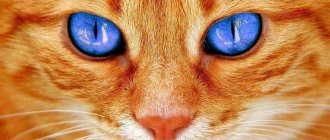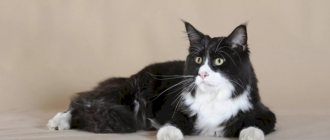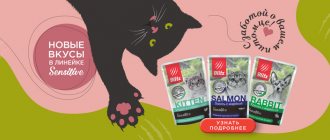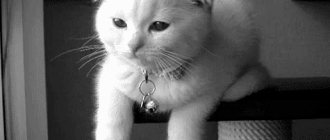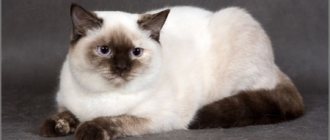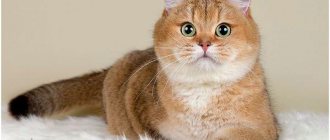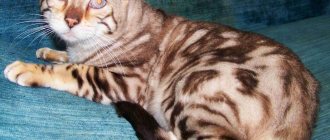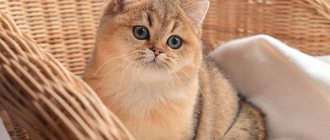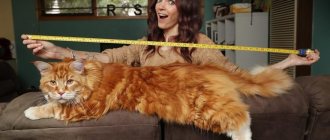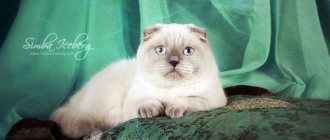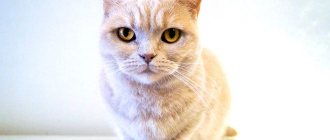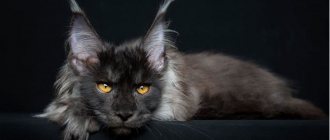Origin of brindle cat breeds
The cat family belongs to a group of mammals from the order Carnivora; they live all over the world. Domestication and artificial breeding of new breeds pleases us with the presence of a pet with an unusual color at home. A prerequisite is dark stripes and spots reminiscent of the coloring of a tiger, leopard or jaguar. Color - from yellow and sandy to dark brown. The body structure is reminiscent of predatory species of wild cats - a long tail, small paws, a head with a wide nose and a thin elongated body with a powerful neck. Miniature tiger.
Purebred breeds of brindle cats are bred only in official nurseries. On average, an adult weighs from 6 to 9 kg.
By the way, our domestic Siberian cat with thick fur that hides the true pattern is directly related to tiger cats. The weight of an adult pet reaches 12 kg. Very loyal to its owner.
Briefly about the breed
The name of the cat breed “toyger” literally translates as “toy tiger”. American biologist-geneticist Judy Sugden bred a miniature copy of the tiger in the 90s, and since 2007 the toyger has been officially recognized by all international associations.
Cats are large animals and weigh on average about 10 kg. Distinctive signs of thoroughbred are the rounded contours of the head and muzzle in the shape of an inverted heart, tilted eyes, smooth movements and a strong, muscular, springy body.
Savannah
A relatively new breed that was recognized by the Cat Fanciers' Association in 2012, the Savannah is known for its unusual appearance. Large, tall ears are located on the top of the head. The savanna is also characterized by a long neck, long legs and a short, thick tail. In addition, these cats have exotic spotted and striped coats. And this is not surprising, the wild appearance of the savannah was achieved by crossing the African serval with a domestic cat.
Temperament of Mini Tigers
The similarity between domestic toygers and wild cats ends in appearance. By nature they are kind, sociable, playful and active.
They do not strive to dominate, but they also do not recognize one master, since they are ready to bestow their attention on everyone. It is not scary to leave small children with such a pet: the cat takes them for younger members of the pack, protects them and protects them.
An interesting feature of animals of this breed is their attention to the human condition. Toyger will not bother you with his presence if he feels that he is not welcome. The cat asks the same thing in response: do not impose affection on a pet who deliberately hides in a corner.
The breed is silent; kittens meow rarely, but always reciprocate a friendly attitude.
Animals are companions, so they can constantly play with their owner, but at certain moments of growing up they can show rebellion and independence.
As for training, natural pliability, intelligence and a desire to please will make the training process comfortable and uncomplicated.
The main thing is not to use the “whip” method often and to instill each skill in the animal with affection.
Asian tabby
The brindle pattern is found among both short-haired and long-haired felines.
The Asian tabby cat is an animal with an exotic tiger color. The color of the coat can reach gray and silver shades, not at all reminiscent of its predatory counterpart. The formation of kittens' coloration can take from several weeks to two to three months. Purchasing an expensive friend is only possible at a specialized breeding farm upon pre-order.
The cost of a pet depends on the pedigree history, color contrast and characteristic pattern. Belonging to a certain class determines the final price. Pet class with differences from the standard color is estimated at 15-30 thousand rubles, Brit class with minimal errors in the standard - from 30-40 without the right and up to 60-70 thousand with the right to further breeding. Show class is a brindle cat with an ideal pattern and the right to breed. It costs from 80 thousand.
Approximate prices for tiger kittens
Tiger kittens are sold in nurseries. Prices depend on the breed.
| Breed | Price, rub.) |
| Toyger | 60,000. For breeding they cost 200,000 rubles, as they are imported from foreign nurseries |
| Oncilla | 140000 |
| Bengal cat | 70000 |
| Tabby | 70000 |
| Sokoke | 60000 |
| Savannah | 500000 |
| Egyptian Mau | 100000 |
| Asherah | 4000000 |
Toyger. Description
An elite of cats, ideally similar to the powerful "big brother". The name comes from the word "tiger". The Toyger breed was developed by selective breeding by mating a Bengal cat and an outbred Indian cat. It has the perfect transverse stripes characteristic of tiger skin. Representatives of the breed have the muscular build of a wild cat and weigh up to 7–8 kg, while cats weigh up to 5 kg. The animals have a wide chest and strong legs, perfect color contrast.
Reproduction in nurseries of this breed is strictly controlled by the owner. The toyger was officially recognized in 2007; the animals are considered rare and valuable. You can buy a kitten for a price of 1 to 2 thousand dollars (approximately 65-130 thousand rubles) depending on the color received at birth. Catteries sell pre-sterilized felines for home keeping. Selection work to breed the ideal miniature domestic tiger continues.
Is it possible to breed Toyger cats?
many owners of purebred cats want to get the same purebred offspring
An inexperienced cat breeder will not be able to breed toygers on his own. The breed is still in its infancy, the characteristics of its representatives are unstable. Therefore, if you want to crossbreed your tiger cat with a male cat, it is better to contact a professional breeder. If the owner breeds his toyger cat with a cat of another breed (or outbred), then the kittens born will lose the purity of the breed. Babies may not display the necessary signs of the standard. Even more experienced breeders, crossing toygers with each other, sometimes get kittens with insufficiently rounded ears, a sharp muzzle or stripes on the stomach. Of course, no one can stop you from taking a chance, but trying to breed may look like you are trying to get striped kittens for sale. Especially if your cat has a pedigree and/or has participated in shows.
If you still have to tie up a cat, then remember the main rule: the cat must be old enough (at least 1.5 years old). The cat must be absolutely healthy, vaccinated and adequate. The female toyger is a shy cat. And there is no need for the cat to offend/hurt her, etc.
In cases where the brindle cat will live the life of a regular house cat, you need to keep in mind the frequency of births. Everyone knows the fact that cats often give birth. However, veterinarians and professional breeders do not recommend breeding a cat more than once a year. The fact is that with frequent pregnancy and childbirth, the cat’s body will not have time to recover. A cat that has just given birth may lose weight, its fur may become dull, and it may generally feel weak and unwell.
Castration and sterilization of toygers
Breeders try to castrate/sterilize the animal while still in the nursery (before the moment when the new owner takes the kitten). This operation involves removing the gonads. The procedure itself lasts about 15 minutes. Usually castration is carried out under local or general anesthesia, and sterilization is strictly under general anesthesia. If you get an unsterilized toyger, wait until puberty (9–10 months) and contact a veterinary clinic. You will be asked to undergo tests and deworm your pet. All that remains is for the cat to come out after the operation.
If the cat was not purchased for breeding, then it must be sterilized
The most difficult thing after surgery is your personal feelings. When my cat was sterilized, I felt incredibly sorry for her. She mumbled something inaudibly, she was constantly drooling and could not get up. Although the vet said she doesn't feel pain. On the second day she recovered from anesthesia, but attempts began to remove the blanket. The knots from the blanket were tied at the back, but she somehow managed to pull it down to her shoulder blades. She made no attempt to lick the stitches, but I have heard of other cats picking at the stitches.
Video: how to care for a cat after surgery
What to feed?
Tabby cats cannot stand monotony in their food. You cannot feed such a cat with dry food alone. You need to regularly change the type of meat, alternating, for example, chicken with beef and fish. Otherwise, the owner risks throwing the cat's lunch in the trash and being left alone with a hungry predator.
The diet must include fresh meat, live food, mineral and vitamin supplements.
The issue of nutrition is fundamental in keeping animals. The diet should be selected depending on the breed, taking into account the advice of experts.
- The toyger has good health and experts do not give any special recommendations for feeding it. It is sometimes recommended to offer solid food to prevent dental disease.
- Bengal cats also have good health, their life expectancy is up to 15 years. Such expensive animals, as a rule, are fed either high-quality natural products - fish, meat, or expensive cat food with vitamins.
- Tender Sokoke are advised to be kept on a balanced diet with vitamin E and taurine, as their heart and metabolism may be weak.
- Mau often suffer from allergies, asthma and heart problems, so they especially need special food for this breed. If your cat has a tendency to these ailments, be sure to feed your pet correctly.
- Posh Ashers are recommended to be given natural products - high-quality beef, poultry, ocean fish, and leave dry food as an additive to the rest of the diet.
- American Shorthair cats love to eat, so that this does not lead to problems, it is recommended to feed them twice a day, and not on demand. Don’t forget to occasionally pamper them with dietary boiled meat, they love it very much.
- If you take up keeping munchkins, then depending on their age, experts advise feeding them 2 to 5 times a day: kittens - more often, and older animals - less often. Babies who are only a few months old are advised to give cereals, dairy products, meat, while adults can be switched to regular food, wet or dry.
- Siberian cats can be very large, and it is important to correctly calculate the amount of food. Typically, 30-60 grams of feed are given per 1 kg of weight. To make the coat look beautiful and shiny, up to 3 years of age, a diet containing 70% protein is recommended.
Balanced diet
The main requirements when preparing a diet for a cat are balance and saturation with microelements. It is better to feed your pets with premium and super-premium food.
Dry food and solid food are required for self-cleaning in the process of feeding plaque.
Sokoke. Description of the breed and its representatives
Medium sized Sokoke cat with marbled tabby pattern on a sandy background. The ears are large with tassels. The slanted look gives an original expression to the face of the graceful representative of the Kenyan forests. Sokoke is the forest African ancestor of Asian cats. The breed was registered in 1993. A distinctive feature of the tiger cat's coloring is the presence of a necklace around its neck. The color of the skin, similar to the bark of a tree, makes it distinguishable from other subspecies.
A miniature copy of a cheetah has a restless character and irrepressible energy. Strong attachment to the owners and playfulness will make the pet unhappy if its owners are constantly absent or busy with work. Sokoke is ready to play around the clock, which is suitable for families with small children. Hide and seek, chasing and constant movement around the apartment are what an active animal needs. African origin makes itself felt with the onset of cold weather, which is difficult for this heat-loving breed to tolerate.
Keeping at home
The tiger cat does not show aggression towards people, but few people have succeeded in turning a wild animal into a domestic cat. A tiger cat will never be a cute pet. The animal loves solitude, is very active at night, has increased jumping ability, during the day it tries to hide on some hill, and has long, sharp claws. Due to their behavioral characteristics, a suitable place for keeping an oncilla will be a spacious enclosure, in which conditions will be created that are close to the natural environment familiar to these animals.
Pixie bob
To develop a breed of cat that resembles a lynx, breeders used short-tailed forest cats. These animals live in the forests of North America. The first cat obtained in this way was named Pixie, which means “Elf” or “Fairy” in English.
The animals are distinguished by a short tail, tufts on the ears and whiskers are possible. Pixies are unpretentious, train well and easily make contact with people.
Interesting Facts
- In ancient Egypt, when a cat died, all members of the owner's family shaved its eyebrows and mourned it. They buried the animal with honor, and during the procession they drank wine and beat their chests. The Egyptian Mau was embalmed and placed in a family tomb or animal cemetery with miniature mouse mummies.
- Toyger is the youngest breed of tiger cat. It was developed based on the requirements of modern life: the animal must become a friend and companion to the owner. So the toyger cat is a design development of breeders. By the way, they continue to be improved with the goal of making them completely similar in appearance to tigers.
- Wild oncilla is almost never kept at home. Only isolated cases of domestication of a predator are known, and their owners keep them not in houses, but in enclosures.
- Tiger cats, unlike many, can speak with their eyes. Their emotions and feelings are immediately imprinted in the expression of their muzzle, and it is quite difficult to distinguish one emotion from another, since they are caricatures.
- And finally, we want to give advice to those who want to have a tabby friend: under no circumstances let your cat go wild. These animals need constant displays of affection and love more than others. Otherwise, they will become withdrawn and even aggressive.
Video
Bengal and Egyptian Mau
The Bengal breed was the result of artificial mating of a wild leopard cat with outbred Californian cats in 1963. The breed was registered in 1983 and is more common than the Toyger.
Egyptian Mau are spectacular cats with short hair and slender legs, with the grace of a queen and large eyes. The four subspecies include smoke and silver with black spots, honey and sand with brown leopard patterns.
When a sacred pet died in ancient Egypt, it was buried with honors in the family crypt or in a separate animal cemetery. The embalmed feline was accompanied to another world by mummified mice.
Breeding
Toygers are bred by professionals. Individuals have the right to position their own kittens as “pets.”
Large catteries operating under the Judy Sugden system sell cats with breeding rights only to reputable breeders. The remaining animals are spayed or neutered.
Before sale, a breeding inspection is carried out, where their thoroughbred is confirmed.
Mating and partner selection
Breeders carefully select partners, trying to emphasize certain traits. The breed is difficult to work with. It takes decades to fix the parameters.
Crossing Toyregs with other breeds is prohibited. The resulting kittens are subject to culling and sterilization.
Pregnancy and childbirth
Toygers tolerate pregnancy and childbirth well. Gestation lasts about 65 days. In a litter, the female brings 4-5 kittens.
Breeders carefully select partners, trying to emphasize certain traits
British and American breeds
The brindle color of the British cat attracts many breeders. Representatives of this breed have an obstinate character and the appearance of a fabulous Cheshire cat. The animal requires a lot of free space for constant movement and a separate place for privacy. The purchase price at the nursery is about 10 thousand rubles.
The American Shorthair is an active and strong cat, ready to jump and play all day long. Tiger stripes can be any color. Long-lived among domestic cat species.
Savannah - leopard breed of "domestic servals"
Work on breeding a cat breed that would be large in size, spotted in color and have a characteristic ear shape began back in the 80s of the last century. After a decade of attempts, breeders managed to create domestic cats similar to servals. For this purpose, an African serval was crossed with a domestic cat. Leopard-printed breeds (Bengal, Egyptian Mau), like the Serval, were used as domestic cats. As a result, a smaller copy of the serval was obtained - Savannah.
Nevertheless, representatives of the Savannah breed are the largest cats in the world (among domestic cats, of course) and can reach 60 cm in height. But in character this breed is not at all wild; on the contrary, it is very calm. Although these cats simply adore active games, as well as walks outside. Apart from everything else, Savannah is one of the most expensive cat breeds.
This concludes our list of cat breeds with brindle and leopard colors. Of course, many domestic breeds can also have stripes or spots on their base coat color. However, they come in a wide variety of colors, and today we were talking about breeds that are exclusively brindle or leopard in color . In conclusion, we suggest watching a video about cute miniature tigers - Toygers.
Scottish cat and munchkin
Scottish brindle cats are characterized by a marbled tabby color on the back and a large M-shaped mark on the forehead. Yellow eyes and small ears characterize this breed. It is estimated at an average of 25 thousand rubles.
The short-legged munchkin is often found with striped coloring. The shades of his stripes come in different colors. Very active and playful, loves to be in the company of small children. Its short legs make it look like a dachshund. This breed has been known since the 90s. You can purchase it from a farm for breeding animals at a price ranging from 5 to 20 thousand rubles.
Color
The color is characterized by stripes ranging from black to brown. An integral part is the highlighted background color. It should be as close as possible to tiger, especially the color of the back.
The mini tiger may have stripes, spots and rosettes. On the muzzle there is a pattern in the form of a butterfly. The cat's round fur is covered with vertical stripes. They are called tabbies. Let's say dark brown.
The peculiarity of toyger wool is its shine and elasticity. The color of the toyger is characterized by relief. This is achieved due to the increased length of the pile in place of the pattern. The breed is classified as shorthaired.
A feature of mini-tigers is the presence of a collar - a thicker coat of hair at the temples and on the cheekbones.
Interesting photo
Calm grace
Yes, it's a tiger, just a small one
After games you need to rest
Before the jump
Handsome Toyger on a green background
Character of domestic "tigers"
The character of a brindle cat is as varied as the patterns on the animal’s skin. Representatives of cats are emotional, which is immediately noticeable by the expression of their eyes and muzzle. They are very active, adapt quickly, inquisitive and intelligent.
The hunter's instinct manifests itself in a constant search for game; sometimes the animal stores food for future use. Night movement around the apartment is dictated by nature's inherent need for safety.
But not all cats have this character. Some breeds, such as the Scots and the British, are very calm and even-tempered. Before purchasing an animal, be sure to consult the breeder. He will tell you about all the features of the breed and the character of the kitten you have chosen.
Coat and colors
Today the brindle color is commonly called “tabby”. It covers the entire body of the animal with stripes, like a tiger, or spots, like a leopard. In this case, the main background can be anything.
Most often, tiger cats have fur of a brown or beige background. The stripes on them are brown, dark red or black. Gray and silver representatives, which do not at all look like predators, were also noted. Some brindles can be tortoiseshell or calico in color.
There are cats with a brindle pattern among short-haired and long-haired breeds. Sometimes kittens are born without stripes, but after 2-3 weeks the stripes definitely appear, but the final formation of color sometimes takes months. The brindle color is surprisingly varied and can combine various elements of pattern, background color, spots and stripes. Since the list of all types of this varied color is quite large, we will consider only the most interesting and common breeds of tiger cats.
How to care
Caring for tiger cats is the same as for other breeds. They need to be fed in a balanced manner.
The basis of the diet should be raw meat, it is advisable to alternate different types: veal, chicken, beef.
You can also feed raw sea fish and boiled river fish. The diet should contain vitamins and mineral supplements. If you feed with industrial feed, then only premium quality.
We suggest you familiarize yourself with: Mollies balloon propagation
Once a week, remove excess hair with a natural bristle brush and clean your pet's ears. Swimming should be done once a month.
Nails are trimmed once a week with special scissors. Visits to a veterinarian (vaccination, deworming) are required.
Brindle cats are known for their cleanliness and for this reason it is necessary to clean their litter box as regularly as possible. Wood shavings are suitable as a filler. It is better to choose a tray with high edges to avoid spillage of the filler when buried.
The animals are active and benefit from daily walks. It would be good if there was a special climbing complex at home. The higher it is, the better.
Features of caring for a tiger cat depend on the length of the coat and lifestyle.
The first rule for owners is mandatory annual vaccinations and supporting the body with vitamins.
Due to their “wild” origin, tiger cats are often very active. They are constantly in search of new and interesting things.
Sometimes they even go on such a spree that they don’t come home to spend the night. And all thanks to the fact that the hunter’s instinct is highly developed in them. They need to wander down the street at least sometimes in search of mythical prey.
The consequence of such a spree is often parasites, such as fleas. Therefore, owners need to carefully monitor this.
The rest of the care for a tiger cat is minimal: you need to comb it once a week and sometimes trim its claws.
Purchasing a toyger kitten
Some other breeds of kittens can be found outdoors. There are times when the owner fails to cope with responsibility and leaves his pet on the street. The cat breeds, but the kittens are born homeless. So with a striped breed this is impossible. Toyger is a new breed (and not the cheapest), which means such kittens could not end up on the street. This means that the kitten can be found from professional breeders or nurseries. There is a chance that your acquaintances will give you a tiger baby, but sometimes it is better to make a little effort than to wait for a miracle. To choose a cat, you need to remember the selection criteria.
In order for your pet to grow into a beautiful, healthy toyger, you need to choose the “right” kitten
Criterias of choice
Those wishing to purchase a real toyger must make their choice, adhering to the following criteria:
- The breeder's reputation must be good.
- Animals kept in the nursery must look healthy and well-groomed.
- The chosen toyger should behave calmly and friendly.
- The breeder must have all the necessary documents.
Find reviews of the breeder/kennel. The activities of the breeder must be transparent and their reputation must be good. When visiting the kennel, make sure the animals are kept clean. All pets should appear healthy and happy. Pay attention to the animals' behavior. If you see a frightened animal with aggressive behavior, this may indicate that pets are being abused. Such animals may experience stress, which means there may be problems with their health or behavior in the future.
the toy cub you like should look like a tiger cub
Ask for documents for the kitten. He must have a veterinary passport with vaccinations. In addition, you can ask for a pedigree. After all, a purebred baby can only be born to purebred parents. If a tabby kitten was born, for example, by a toyger cat, and its father is a purebred tabby cat, then you may not be provided with a pedigree. This is especially important if you plan to participate in championships and cat shows in the future.
At what age is it better to adopt a toyger?
Kittens should not be adopted immediately after birth. Breeders and veterinarians recommend adopting a baby from the age of three months. There are several reasons for this:
- primary immunity;
- vaccinations;
- raising a cat.
With mother's milk, the kitten receives primary immunity. This is the only way the baby will grow up strong and healthy. In addition, the mother cat will teach her cub to eat properly, go to the litter box and play. Kittens separated from their nurse early may grow up unadapted to life. And most importantly - vaccinations. Usually, up to three months, kittens receive the most important vaccinations. Even if you persuade the breeder to give the kitten away a little earlier, he may require you to sign an agreement in which such an obligation will be indicated. But in general, professionals do not give away purebred kittens early. The new owner may be irresponsible, and in the world of breeders, the loss of every kitten is a terrible loss. There can be only one exception to this rule - the death of a cat. If a toyger cub is left without a mother, a person will have to feed it (first from a pipette, then from a bottle). Not all breeders can cope with the great responsibility, so such a baby may be given away.
It is not recommended to adopt a kitten under three months old
I had to feed a kitten with a pipette. It's difficult and scary. Small kittens (especially while they are blind) may snort, gag, and turn away. But the baby must gain weight, so it is important that he still eats.
Additional care
Artificially created varieties of the tiger breed are highly prized. Genetic studies prove a direct connection between the genes responsible for body color and the animal’s immunity. Selected cat breeds, despite the fact that their wild counterparts have excellent immunity, require additional attention to the nutrition and care of the pet.
The need for annual vaccinations and additional vitamins is mandatory for valuable representatives of the feline class. Monitoring the health of the eyes, heart and blood vessels will allow timely prevention of possible disease.
Representatives of many tiger breeds are long-lived; their lifespan is about 20 years with proper nutrition and lifestyle. The need for walks in the fresh air obliges the owner to think through ways and times for such activities.
Appearance
The Toyger is a massive cat, reaching up to twelve kilograms in weight. Large, with large bones and heavy paws, it is a real predator. The standard prescribes the following characteristics for the breed.
Head.
Elongated, heart-shaped muzzle. Rounded ears. Small, deep-set eyes with half-lowered eyelids are distinguished by rich colors. Elongated nose, widening towards the end.
Frame
Low and long body, wide neck and chest. Powerful athletic paws. A wide, downturned tail with a rounded end.
Wool
Short, plush fur with a rich golden sheen. The pattern is “relief”: dark hairs are longer than light ones. The undercoat is soft and uniform. There is no ticking.
The main feature of the toyger is a modified tabby mackerel, a rare striped color. The main background is always contrastingly different from the color of the stripes.
The pattern consists of clear and bright vertical stripes covering the entire body and paws. The tip of the tail and paws are black. Stripes also cover the face. There are white “glasses” around the eyes.
Health
Typically, wild-type animals are very resilient and disease-resistant, unlike their bred counterparts. Modern genetic studies have shown that the T gene, which determines the brindle color, is directly related to immunity.
We invite you to read: The main difference between food for sterilized cats and regular food: how to choose
Artificially created breeds, more than the descendants of their “wild” counterparts, are susceptible to diseases such as:
- cardiomyopathy;
- cardiac hypotrophy;
- cataract;
- feline leukemia.
The rest of the “tiger cubs” mostly suffer only from the same diseases that ordinary domestic cats suffer from:
- colds;
- infections;
- poisoning
What kind of breed, how did it come about?
Tiger cats are very interesting and mysterious creatures. Thanks to their unusual coat color, some of them resemble small tigers, others resemble leopards and even jaguars. Some tiger breeds have remained alive in the wild, but the majority have long been domesticated. There are also artificially created breeds that are quite expensive. Next we will talk about the most common breeds of tiger cats.
Tiger cats (lat. Leopardus) are a genus of the cat family, the order of carnivores. The Latin name of the genus has nothing to do with leopards; tiger cats are classified as a subfamily of small cats. They are distinguished by gray or yellowish-brown fur, which necessarily has patterns in the form of stripes or black spots. All representatives of this genus live in the New World, most of all in Central and South America.
The tiger genus dates back a very long time. These were wild cats that lived in different parts of the world. And today some representatives of the genus remain among the wild. But there are varieties created artificially.
Nutrition
The diet of a domestic predator should be varied, it includes meat and lactic acid products, vegetables, and vitamin supplements. Unable to tolerate a monotonous diet due to their being natural hunters, tiger individuals consume only fresh, nutritious food. Long-haired cats that undergo seasonal shedding require additional care. Frequent bathing is not particularly recommended; animals clean their own fur.
Striped felines have become so close to humans that life without them becomes boring and uninteresting. But it’s not always worth “chasing” a breed. Any stray cat can turn into a gorgeous, handsome cat, feeling the care and affection of its owner.
